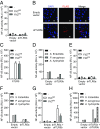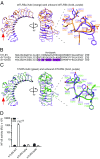Duplicated TLR5 of zebrafish functions as a heterodimeric receptor
- PMID: 29555749
- PMCID: PMC5889648
- DOI: 10.1073/pnas.1719245115
Duplicated TLR5 of zebrafish functions as a heterodimeric receptor
Abstract
Toll-like receptor 5 (TLR5) of mammals, birds, and reptiles detects bacterial flagellin and signals as a homodimeric complex. Structural studies using truncated TLR5b of zebrafish confirm the homodimeric TLR5-flagellin interaction. Here we provide evidence that zebrafish (Danio rerio) TLR5 unexpectedly signals as a heterodimer composed of the duplicated gene products drTLR5b and drTLR5a. Flagellin-induced signaling by the zebrafish TLR5 heterodimer increased in the presence of the TLR trafficking chaperone UNC93B1. Targeted exchange of drTLR5b and drTLR5a regions revealed that TLR5 activation needs a heterodimeric configuration of the receptor ectodomain and cytoplasmic domain, consistent with ligand-induced changes in receptor conformation. Structure-guided substitution of the presumed principal flagellin-binding site in human TLR5 with corresponding zebrafish TLR5 residues abrogated human TLR5 activation, indicating a species-specific TLR5-flagellin interaction. Our findings indicate that the duplicated TLR5 of zebrafish underwent subfunctionalization through concerted coevolution to form a unique heterodimeric flagellin receptor that operates fundamentally differently from TLR5 of other species.
Keywords: TLR5; flagellin; heterodimer; subfunctionalization; zebrafish.
Conflict of interest statement
The authors declare no conflict of interest.
Figures







Similar articles
-
Extension and refinement of the recognition motif for Toll-like receptor 5 activation by flagellin.J Leukoc Biol. 2018 Oct;104(4):767-776. doi: 10.1002/JLB.3VMA0118-035R. Epub 2018 Jun 19. J Leukoc Biol. 2018. PMID: 29920759
-
Determination of the physiological 2:2 TLR5:flagellin activation stoichiometry revealed by the activity of a fusion receptor.Biochem Biophys Res Commun. 2013 May 24;435(1):40-5. doi: 10.1016/j.bbrc.2013.04.030. Epub 2013 Apr 25. Biochem Biophys Res Commun. 2013. PMID: 23624387
-
Structural basis of TLR5-flagellin recognition and signaling.Science. 2012 Feb 17;335(6070):859-64. doi: 10.1126/science.1215584. Science. 2012. PMID: 22344444 Free PMC article.
-
Structural engineering of flagellin as vaccine adjuvant: quest for the minimal domain of flagellin for TLR5 activation.Mol Biol Rep. 2025 Jan 7;52(1):104. doi: 10.1007/s11033-024-10146-y. Mol Biol Rep. 2025. PMID: 39775323 Free PMC article. Review.
-
AsialoGM1 and TLR5 cooperate in flagellin-induced nucleotide signaling to activate Erk1/2.Am J Respir Cell Mol Biol. 2006 Jun;34(6):653-60. doi: 10.1165/rcmb.2005-0441OC. Epub 2006 Jan 26. Am J Respir Cell Mol Biol. 2006. PMID: 16439799 Free PMC article. Review.
Cited by
-
Unravelling turbot (Scophthalmus maximus) resistance to Aeromonas salmonicida: transcriptomic insights from two full-sibling families with divergent susceptibility.Front Immunol. 2024 Dec 6;15:1522666. doi: 10.3389/fimmu.2024.1522666. eCollection 2024. Front Immunol. 2024. PMID: 39712009 Free PMC article.
-
Editorial: Ligands, Adaptors and Pathways of TLRs in Non-mammals.Front Immunol. 2019 Oct 17;10:2439. doi: 10.3389/fimmu.2019.02439. eCollection 2019. Front Immunol. 2019. PMID: 31681318 Free PMC article. No abstract available.
-
Functional characterization of Vibrio alginolyticus T3SS regulator ExsA and evaluation of its mutant as a live attenuated vaccine candidate in zebrafish (Danio rerio) model.Front Vet Sci. 2022 Aug 8;9:938822. doi: 10.3389/fvets.2022.938822. eCollection 2022. Front Vet Sci. 2022. PMID: 37265802 Free PMC article.
-
Genome-wide identification and characterization of toll-like receptor 5 (TLR5) in fishes.Front Genet. 2023 Jan 6;13:1083578. doi: 10.3389/fgene.2022.1083578. eCollection 2022. Front Genet. 2023. PMID: 36685837 Free PMC article.
-
Fish TLR5 develops a taste for viral RNA.EMBO Rep. 2022 Aug 3;23(8):e55443. doi: 10.15252/embr.202255443. Epub 2022 Jun 28. EMBO Rep. 2022. PMID: 35762506 Free PMC article.
References
-
- Medzhitov R. Toll-like receptors and innate immunity. Nat Rev Immunol. 2001;1:135–145. - PubMed
-
- Leulier F, Lemaitre B. Toll-like receptors–Taking an evolutionary approach. Nat Rev Genet. 2008;9:165–178. - PubMed
-
- Gay NJ, Gangloff M. Structure and function of Toll receptors and their ligands. Annu Rev Biochem. 2007;76:141–165. - PubMed
-
- Poltorak A, et al. Defective LPS signaling in C3H/HeJ and C57BL/10ScCr mice: Mutations in Tlr4 gene. Science. 1998;282:2085–2088. - PubMed
MeSH terms
Substances
LinkOut - more resources
Full Text Sources
Other Literature Sources
Molecular Biology Databases

